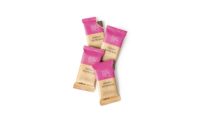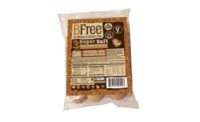Super-Soy THAT
By Kathie Canning
Soy’s the super-ingredient that does it all, giving snack and bakery items everything from health benefits and a longer shelf life to enhanced texture and crunch appeal.
They’re seemingly everywhere — new products flaunting flavonoids, Omega-3 fatty acids and other wonder ingredients that promise amazing health benefits. With all the fuss made over these new kids on the block, it might seem as though consumer interest in soy — the granddaddy of healthful ingredients — is waning. But that simply is not the case.
“Consumers are not losing interest in the other healthy aspects of the market,” says Jim Skiff, president of Mattoon, Ill.-based U.S. Soy LLC. “They’re just adding to it. Soy is kind of the forerunner of this healthy interest.”
In fact, a 2006 United Soybean Board survey found that the number of consumers who view soy products as “healthy” is at an all-time high. (See “Soy Survey,” on p. 42.)
“Soy is an excellent source of protein and is the only vegetable protein containing all nine essential amino acids,” says Cheryl Borders, manager of soy foods applications for Decatur, Ill.-based Archer Daniels Midland Co. (ADM). “The protein quality of the soy protein products compares favorably to animal proteins while also being an economical protein source. Soybean oil is the largest category within the soy ingredient line and is one of the few non-fish oils that contain linolenic acid, an Omega-3 fatty acid.”
In addition, research has linked the consumption of soy ingredients with decreased risk for numerous health conditions, including heart disease, some cancers, diabetes, osteoporosis and certain menopausal symptoms. Soy protein also shows promise in weight control.
“Concentrated sources of soy protein such as isolated soy protein are a perfect way to increase the protein content of a wide variety of foods, including snacks and bakery goods,” says Mark Messina, president of Eau Claire, Wis.-based Nutrition Matters Inc. “This is important to consumers because research increasingly suggests protein is more satiating than fat and carbohydrates and, as a result, higher-protein diets may help with weight control.
“Furthermore, about 30% of women in the country don’t meet the RDA for protein — that figure is about 40% for older women,” he adds.
Rob Kirby, president of Nexcel Natural Ingredients, a division of Springfield, Ill.-based Spectrum Foods Inc., emphasizes that soy has staying power. Unlike many of today’s fad ingredients, soy boasts health benefits that have been well proven, documented and communicated to the public.
“I think there will always be the next ‘hot’ ingredient, but soy can be easily incorporated into a wide variety of products and enjoys marketability as an ingredient,” he stresses.
The soy market is beginning to reach a “maturation phase,” contends Deborah Schulz, market development manager for Cargill Health & Food Technologies, Minneapolis. “We need to keep the word out there so people don’t forget about it in the face of the latest thing that’s coming out — to educate both healthcare professionals and consumers in that soy should be a staple in the diet. It’s protein, it’s good for you, and it should be something that you’re just using routinely in your diet.”
Bonus Benefits
Although healthful ingredients are important to today’s aging Baby Boomers and other nutrition-conscious consumers, appearance, texture and, most importantly, taste are product essentials. Fortunately for snack food and bakery product developers, soy ingredients bring positives to these vital areas, as well.
Soy flour, for example, can impart several functional benefits to bread products.
“You’re adding protein, but you’re also going to extend the shelf life of bread products because soy absorbs moisture,” Skiff says. “It also acts as a bit of a bleaching agent; for example, it will make white bread products appear whiter.
“Because of the moisture it absorbs, it will also keep something more pliable for a longer period of time,” he adds. “For instance, a tortilla will stay more pliable and more flexible longer with soy added to it.”
When added to doughnuts, soy flour actually helps reduce fat absorption during the frying process, Schulz says. And textured soy flours and soy protein crisps can impart desired texture improvements to items such as snack and protein bars. But because soy protein crisps cost more than traditional crispy pieces, she says, processors would probably opt to use them only for formulations in which protein benefits are desired, such as in nutrition bar applications.
Soy ingredients also mesh well with the development of high-protein, lower-fat snack food and bakery products, says Mian Riaz, director of the Food Protein R&D Center at Texas A&M University.
“[Soy protein] can give more weight per loaf since soy protein can hold more water,” Riaz explains. “This may result in one or two extra loaves per batch.” In addition, soy protein can reduce the cost of some formulations, he says. For example, lecithinated soy flour might replace liquid eggs in cake and cookies.
Still other benefits soy ingredients bring to the table, Borders says, include enhanced gelling abilities, emulsification and moisture retention, added fiber, and reduced trans fatty acids in the finished product (with soybean oils).
Latest & Greatest
New technology developments in the soy arena are working to further extend the ingredients’ uses. Among the more significant of these, Borders says, is the development of soybean varieties with a low linolenic content (reducing the need for hydrogenation); the development of soybean varieties with blander flavor profiles; improved processing parameters that significantly reduce off flavors in soy proteins; and the availability of soy proteins in a wide range of functionalities.
Soy ingredient suppliers also have worked hard to improve and expand their offerings.
Kirby credits Nexcel’s unique expeller process for allowing the company to manufacture its Nexsoy soy flour and soy grits without the traditional soy taste and smell associated with the traditional solvent-extraction method.
“The benefit to users can be a higher inclusion rate (higher protein) without affecting flavor and/or improved flavor when used in place of commodity solvent-based soy flour,” he says. “New for this year are mid- and high-pdi soy flours, which can go into solution very easily and can be used in a variety of applications.”
For its Prolisse soy protein isolate, Cargill developed new technology that also improves flavor, says Schulz. Several studies — performed both internally and externally by a third party — back up the flavor claim.
“We’re just in the process of launching a new brand logo — Prolisse — as the natural soy protein,” she adds. Also new from Cargill is a pretzel that uses Prolisse and the company’s Oliggo-Fiber inulin.
“Those are two things that consumers are interested in right now, both protein and fiber,” Schulz says. “The pretzels a good source of both.”
Cargill also offers Prolia soy flour and Prosante textured soy flour, which can replace or reduce animal protein, boost fiber, increase yields, reduce formulation costs and more in breads, buns, snacks, doughnuts and many other snack and bakery foods.
Meanwhile, Skiff is excited about two new U.S. Soy offerings: roasted soy flour and soy fiber flour.
“The soy flour [is made] by milling our roasted soy nuts,” he explains. “You’ll obviously get a darker color because it’s roasted soy nuts, and you’re going to get more of a roasted taste to it. It’s not as finely milled as flour because of the roasted texture … so if you’re looking for something that’s going to add more of a crunchy texture or a bit more of a heavier mouthfeel to a product, this is a good way to do that. And at the same time, the product retains all the benefits of the whole soybean.”
As for the soy fiber flour, Skiff says it is made from soy hulls.
“We can get 50% to 65% of fiber product, and we make a fiber flour,” he explains. “That could be used in the bakery industry and/or as a filler in any type of product where you want to add more fiber. And you will still get a fair amount of protein in there as well.”
Borders points to ADM’s wide range of soy ingredient products as a benefit to snack and bakery applications. From its NutriSoy soy protein line of flours, concentrates, isolates, textured pieces and organic whole bean powder to its Yelkin, Ultralec and Beakin soy lecithins to its Enova oil, the company has just about every conceivable application covered.
Grinnell, Iowa-based Natural Products, Inc. (NPI), a supplier of enzyme-active (raw) and roasted full-fat soy ingredients, says it uses only clear hilum soybean varieties in its processes. These varieties have a consistent creamy color. The company also can supply soybean varieties bred for specific traits, including high-sucrose, high-protein and certified organic varieties.
No matter what soy ingredient they elect to use, food processors need not go it alone when it comes to formulation. Just about every soy ingredient supplier is ready to assist in product development efforts. And USB also is willing to lend a hand.
“Food companies are welcome to contact USB by e-mail [info@talksoy.com] or at the USB booth at tradeshows such as IFT and IBIE [International Baking Industry Exposition] to speak with one of our technical experts,” a USB spokesperson says.
SF&WB
SF&WB
| Soy Survey | |
| In an annual survey, the United Soybean Board asks consumers whether or not they view soy products as “healthy.” For 2006 — the first year in which the survey was conducted online and not by phone — consumers’ perception of soy products as healthy reached an all-time high. | |
| Year | % of Respondents That Rated Soy Healthy |
| 1998 | 67% |
| 1999 | 71% |
| 2000 | 76% |
| 2001 | 69% |
| 2002 | 74% |
| 2003 | 74% |
| 2004 | 74% |
| 2005 | 78% |
| 2006 | 82% |
| Source: The United Soybean Board | |
How to Build a Better Cookie
A gluten-soy protein isolate combination shows potential as a carbohydrate replacer in sugar snap cookies, say researchers at USDA’s Cereal Products and Food Science Research Unit.
According to the Swiss journal LWT - Food Science and Technology, the researchers looked at protein blends of vital gluten and soy protein isolates formulated at 70:30, 50:50 and 30:70 ratios, with flour replacement varying from 10-30%.
For the 70:30 and 50:50 blends, the journal reported that 20% flour replacement resulted in a cookie texture about the same as that of cookies with no flour replacement. For the 30:70 blend, a flour replacement of 25% was achieved with similar results.
Although the idea of using composite flours is not new, previous efforts yielded quality problems such as hard or crumbly cookies. This study’s results bode well for processors that want to increase the nutritional content of cookies, as well as for those who want to appeal to the remaining low-carb market.
Operation Oil
The United Soybean Board has been working with industry leaders and public and private seed breeders to develop soybean oil that requires no hydrogenation but exhibits the same superior functionality and flavor characteristics we’ve come to expect from soybean oil. Soybean oil applications that meet the standards will carry the QUALISOY certification mark.


